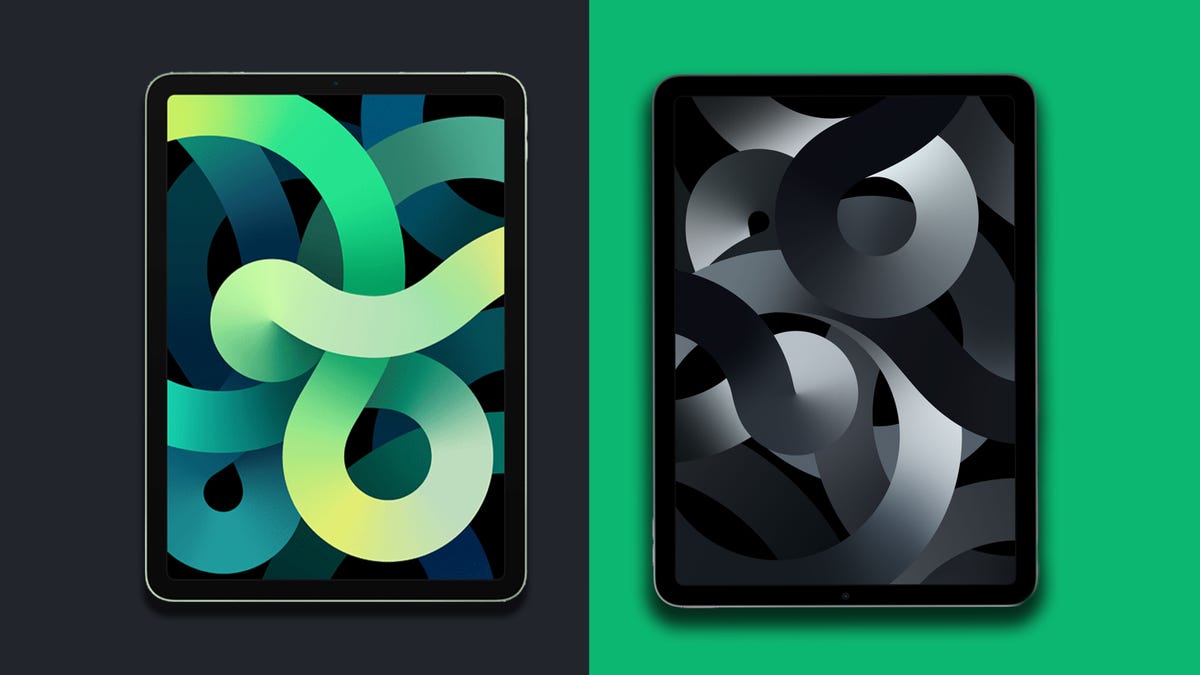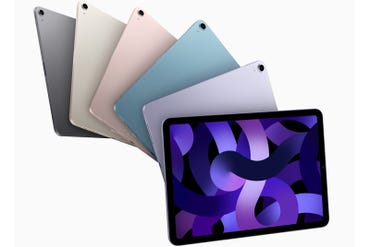
iPad Air has arrived
bearing the mantle as the fifth generation of Apple’s lightweight and ultra-portable tablet lineup. From the outside, the 2022 entry looks and feels a lot like its
2020 predecessor
; Thin, symmetrical bezels, a 10.9-inch display, all housed in a cool-to-the-touch, aluminum body.
But in the new iPad, Apple is giving it a breath of fresh air by embedding an industry-disrupting M1 processor, a new front-facing camera, and the buzzword of the decade: 5G.
Whether you’re an iPad Air (2020) user who’s considering an upgrade or a first-timer who’s split between the two latest Air models, we’ve broken down the key similarities and differences to help you make the best buying decision. Let’s begin.
Design
On the design front, both iPad Airs are headlined by a 10.9-inch Liquid Retina display, capable of up to 500 nits of brightness. The LED panels support Apple’s True Tone, which calibrates the color and intensity of the displays for a comfortable viewing experience no matter the lighting condition. They also support the
second-generation Apple Pencil
for your stylus needs.
The same array of USB-C port, speakers, TouchID scanner, and pins to connect to a
Magic Keyboard
can be found across both iPad models. Likewise, the single 12-megapixel camera on the back remains unchanged in the new Air. (More on the cameras later.)

All the color options for the 2022 iPad Air.
Image: Apple
One change in appearance is the color options that Apple offers. The iPad Air (2020) comes in Space Gray, Silver, Rose Gold, Green, and Sky Blue. Whereas the iPad Air (2022) comes in Space Grey, Starlight, Pink, Purple, and a darker Blue.
Clearly, the design of the iPad Air (2020) was good enough to not warrant any major shifts in hardware two years later. You’ll enjoy and appreciate Apple’s industrial design no matter which of the two you buy.
Performance
The saying, “You can’t teach an old dog new tricks,” doesn’t really apply to the iPad Air (2022). In fact, underneath the familiar glass and aluminum exterior is Apple’s ARM-based, eight-core CPU, M1 chip. Trickling down from the MacBooks and iMacs, Apple’s M1 chip rates for up to 60% faster and more powerful than its Bionic counterpart — like the A14 found on the 2020 iPad Air. That’s a pretty significant step-up, considering both iPads start on equal footing with 8GB of RAM.
With normal tasks like social media, browsing, and streaming movies and videos, the difference in performance between the M1 and A14 Bionic will be unnoticeable for most users. But when handling graphics-intensive apps, such as 4K video editors, 3D racing games, augmented reality, or multitasking, the processing gap is evident. With the M1 at its core, the iPad Air (2022) even gives the higher-end iPad Pro a run for its money.
More: iPad Air (2022) vs iPad Pro (2021): What’s the difference?
Both iPad Airs have two storage options: 64GB and 256GB. Given the portable nature of the Air, you’ll likely find yourself working from it on the go. That makes local storage all the more important and the base 64GB all the more underwhelming. I’d recommend upgrading to the 256GB variant, no matter which version you buy.
Camera
Camera performance isn’t typically the key selling point for tablets, let alone iPads. But with this year’s iPad Air, Apple does emphasize its new and improved front-facing camera.

Image: Apple
While the 12MP rear camera remains untouched, the front now houses a 12MP ultra-wide camera. With a wider field of view than the previous generation’s 7MP FaceTime HD lens, the new iPad can take advantage of Center Stage, Apple’s webcam feature that tracks and follows your face as you move around. This is particularly useful for presentations and FaceTime calls with friends and family.
Besides that, both iPads are capable of recording 4K video and reliable enough for the usual point-and-shoot.
Battery
Apple tends to keep battery capacities and specs under the rug but does state on its website that both the 2020 and 2022 iPad Air can last up to 10 hours of web browsing on Wi-Fi, and up to nine hours on a cellular data network. We had similar results when testing the two.
In fact, when ZDNet contributor Jason Cipriani reviewed the iPads, he had no trouble getting a full workday of use, even with the Magic Keyboard connected. There’s something to be said about the M1 chip on the new iPad, though. With its improved power efficiency and smooth handling of professional-grade apps, marginally better battery life is to be expected.
Eventually, when you do need to top up, both iPad Airs come with a 20-watt charger (brick and cable) in the box, and that’s as fast as they will charge.
Connectivity
Besides the more efficient M1 processor, there are a couple more improvements on the new iPad Air that may or may not affect your usage.
The first upgrade is 5G cellular connectivity. Though not mmWave 5G, the sub-6 GHz bands on the iPad Air (2022) allow you to connect to the fifth-gen network and access faster download speeds than the 4G LTE of the iPad Air (2020). You will, of course, need to be under a 5G data plan, have the appropriate nano-SIM card (or eSIM), and purchase the more expensive, cellular version of the iPad, in order to reap the benefits of the faster network.
More: Where we are with 5G and where we’re going next
Another upgrade comes in the form of the new iPad Air’s USB-C port. It now supports external monitors with a 6K output (versus the 2020’s 4K) and transfers photos, videos, and files at 10Gbps. That’s double the speed of the fourth-generation iPad Air. With the faster output, you can theoretically connect the new iPad to Apple’s $1,600 Studio Display.
Price
Even with the all-around improvements, Apple sells the fifth-generation iPad Air for the same price as its predecessor. At retail, either model can be had for
$599 (64GB)
$749 (256GB)
. That is, again, if you’re buying the iPads at retail. With the release of the new Air, most stores and websites have since marked down the 2020 model as a means to clear out inventory.
Right now, we’re seeing major retailers list the iPad Air (2020) for as low as
$499 ($100 off)
, and there is no telling whether that price will go any lower before it’s completely discontinued.
Whether you’re new to the iPad experience or are a current owner of the iPad Air (2020), making the switch to the latest model boils down to three things: 5G, Center Stage, and M1. If you seek an iPad that’s future-proof and capable of handling any task you throw at it, then the iPad Air (2022) is worth the pickup. But if you can live without the connectivity quirks and just want a no-frills, iPadOS experience, then save yourself the money by sticking with the iPad Air (2020).
Alternatives
Still up in the air about which iPad to buy? You may also want to consider these ZDNet-tested tablets:
Stay connected with us on social media platform for instant update click here to join our Twitter, & Facebook
We are now on Telegram. Click here to join our channel (@TechiUpdate) and stay updated with the latest Technology headlines.
For all the latest Technology News Click Here
For the latest news and updates, follow us on Google News.
